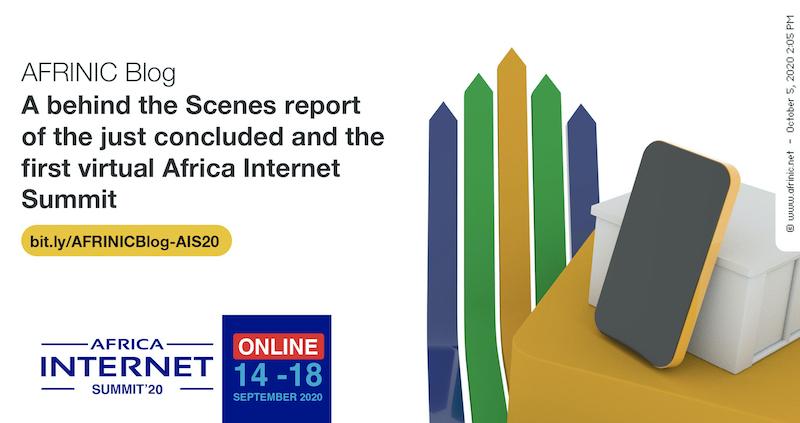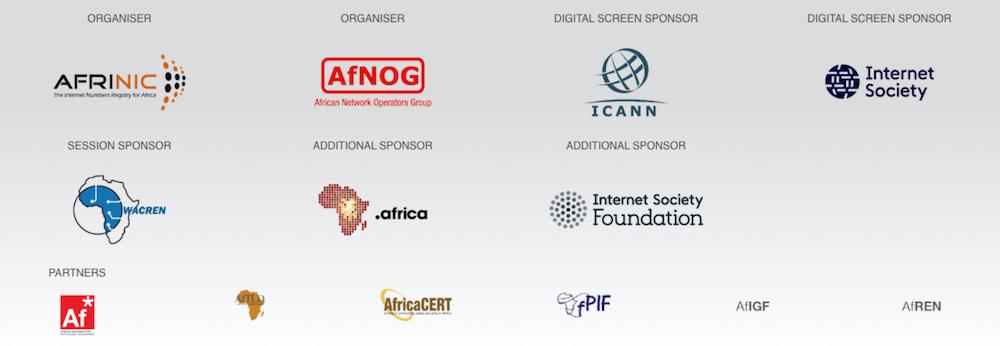A New Experience
 The African Network Information Centre (AFRINIC) in collaboration with the Africa Network Operators Group (AfNOG) have proudly concluded their first virtual conference (AIS’20).
The African Network Information Centre (AFRINIC) in collaboration with the Africa Network Operators Group (AfNOG) have proudly concluded their first virtual conference (AIS’20).
The event took place virtually from 14 to 18 September 2020 and was attended by over 500 delegates. This was our first time to organise an online version of the Africa Internet Summit (AIS’20).
We are extremely proud of how the meeting went and the valuable lessons learnt throughout the process of organising and running such meetings.
We wanted to share with you the “behind the scenes” challenges that never made it to your screen and the valuable lessons learnt that could help other online meeting organisers in the future.
The Platform
 Finding the right platform for AIS has been an interesting challenge in itself. The AIS team had to look for an inclusive and easy to use platform that could accommodate the number of expected participants.
Finding the right platform for AIS has been an interesting challenge in itself. The AIS team had to look for an inclusive and easy to use platform that could accommodate the number of expected participants.
After reviewing a long list of popular meeting platforms, it was clear that ease of use and scalability were not the issue, however, inclusivity, which is a vital part of the AIS DNA, was a major challenge. This lead to the disqualification of many platforms which have limited or no access in several countries in our service region. We finally decided on working with the Meetecho team to custom-build a platform tailored to our needs. Meetecho is an online platform that is entirely web-based and does not require software installation.
The platform is accessible from anywhere in the world without restrictions. We also had to ensure that the meeting platform, interpretation and transcription services worked holistically despite being offered by different suppliers. We deployed such setup during our face-to-face meetings but for the virtual conference, this was not as straightforward as we could imagine.
Lesson learned here is the test, then test and triple test everything without making assumptions.
The Registration Process
We had a new perspective on online registration. Participants interested in attending AIS’20 had to register before a set deadline to receive a meeting token to access the meeting. It is worth noting however that within a short time following the call to register we had over 600 registrants well ahead of the deadline which is never the case with face-to-face meetings.
By the registration deadline, we had 697 delegates registered for AIS’20 Online. Registered participants would use their unique token to access the Meetecho platform and join the virtual meeting.
Participants who did not register were still able to follow AIS’20 Online through the live stream on Youtube and Facebook channels set up by the AIS Meeting team. However, those participants could not directly interact with other online attendees or speakers as was the case for those who were registered. They could, however, provide comments and questions via the Jabber room which was made available for participants who were following through the live stream.
Rehearsal
As part of the testing, we invited the delegates to interact with the meeting platform one week prior to the meeting. We had to check everything from audio and video connectivity to integrating captioning and interpretation services. This was also a chance for the presenters to familiarise themselves with the meeting platform as they tested their presentations. Even with all the testing we still ended up facing some challenges with presentation projection and the audio especially when meeting participants would switch to a different language channel but this was only for the first two days.
AIS’20 Online
Overall, statistics indicate that over 500 unique participants logged in to attend the meeting over the period of the five days. We had:
The meeting had a packed agenda that ran for four hours throughout the five days with over 50 presentations that also included technical panel discussions, updates from several AF* organisations, community engagement sessions and the AFRINIC Annual General Members Meeting. For more information on the sessions and presentations please click here.
While most speakers used the platform for sharing their slides and making their presentations, the AIS team offered support to speakers who required assistance with sharing slides on the platform. The overall experience was good although in the first few days we experienced a few technical fallouts. However, the team learned to tackle such issues as they came through and our meeting moved on more seamless as it progressed. We brought these challenges in our lessons book.
Elections
The virtual conference meant that AFRINIC elections were held fully online for the first time. This resulted in a shift in procedures for holding elections. The AFRINIC Board and Governance Committee Elections which are reserved for members were carried out exclusively on MyAFRINIC while community elections for the NRO NC and PDWG elections required a screening process whereby voters’ identity and eligibility were duly verified. There was also a voting process for special resolutions on the changes on the AFRINIC bylaws. 14 out of the 28 resolutions passed.
The community provided feedback that the voting process for the bylaws resolutions was quite tedious and suggested that AFRINIC improves on the process. Online elections were successfully held for various positions; AFRINIC Board Vacancies, one Governance Committee seat, Policy Development Working Group co-chair and one NRO NC position.
Policy Discussions
We had vibrant community discussions on ten policies during the PDP sessions held on 16 and 17 September 2020. Eight of these did not reach a consensus while the other two reached a rough consensus subject to some changes on the policies by authors.
Technical Performance
The technical team set up a monitoring system to review the performance. The following graphs highlight how our infrastructure performed during our virtual meeting. As more people joined the meeting the network usage started to peak on each day. On the first day, we got the highest network traffic.

Streaming also requires CPU power to process the video and audio, the highest CPU usage matches the first day where we saw the highest number of concurrent participants joining.

Meeting Partners and Sponsorship
It is important to acknowledge our AIS'20 Online Sponsors. This meeting was sponsored by ICANN, ISOC, dotAfrica and WACREN. We appreciate your continuous support.

What’s Next
 AIS’20 Online was a rich learning experience for the whole team which brought as many challenges as opportunities. We are thankful to everyone, including the community, that supported us through the whole process and exercised patience especially when things broke.
AIS’20 Online was a rich learning experience for the whole team which brought as many challenges as opportunities. We are thankful to everyone, including the community, that supported us through the whole process and exercised patience especially when things broke.
The AIS team is now looking forward to the next AIS event which is scheduled for mid-May/June 2021. Whether the next AIS will be online or face-to-face or a hybrid of both remains undecided. As we get ready for the next AIS in 2021, we remain open to any scenario given the context and evolution of the pandemic. With the experience acquired and taking aboard the new lessons learnt, we are now geared up for AIS 2021.


